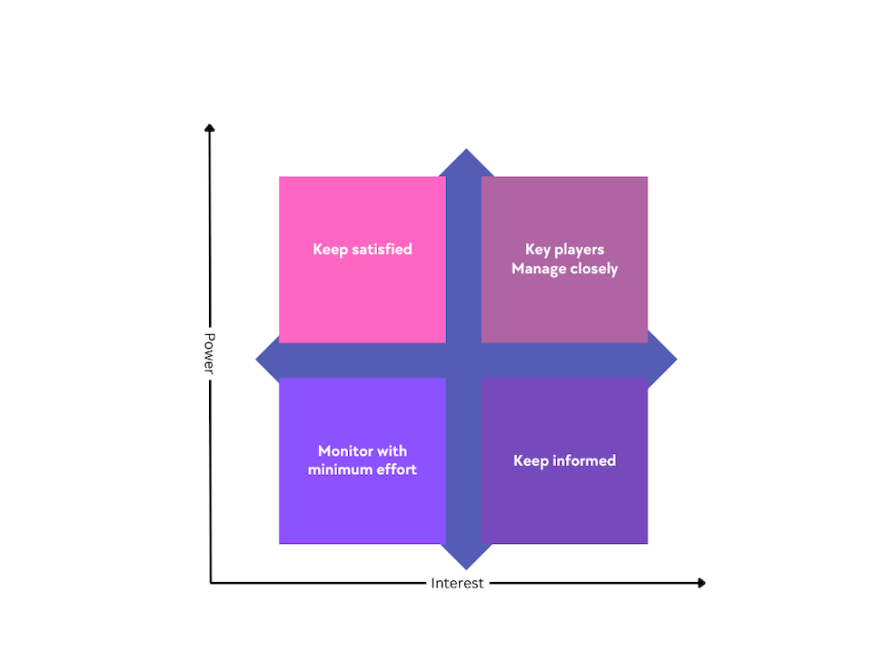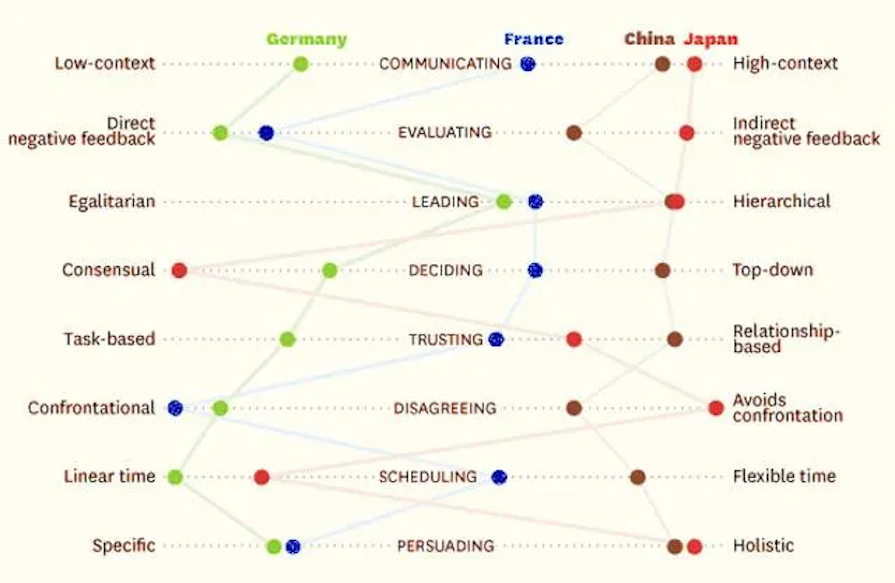A stakeholder matrix helps anyone who works with others to identify problems, understand needs, and define an engagement plan for all relevant stakeholders. While more senior product managers might perform stakeholder management without using a tool, the stakeholder matrix is particularly helpful if you are at the beginning of your journey or want to communicate your stakeholder engagement plan with others.

In this article, you will learn how to create a stakeholder matrix, alongside best practices for using one in your product work.
A stakeholder matrix is a chart that shows the levels of interest and involvement of particular people or organizations within a project, business, etc.
While there are multiple versions of the stakeholder matrix, we will look at the most common one — the Power Interest Grid. Aubrey L. Mendelow created the Power Interest Grid in 1991 as a way to manage stakeholders in a project:

Stakeholders are any person from inside or outside the company who:
Judging by the criteria mentioned above, it goes without saying that different stakeholders may have conflicting opinions or will push for their interests regarding product decisions.
Professionals in the project management practice categorize stakeholders into five levels depending on their interest and attitude towards a project: unaware, resistant, neutral, supportive and leading. Let’s look at each type individually and see how to use the stakeholder matrix to devise engagement strategies.
People who know nothing or very little about the project and its impact. They’re not engaged or informed about the project and its progress.
In this category, individuals are aware of the project, but are actively opposing it. They’re detractors who could be either afraid of change — part of the “but we have always done it this way” crowd — or have a conflict of interest with another project or initiative.
These members are aware of the project, but don’t actively support or oppose it.
This type of stakeholder understands and endorses the project. They’re willing to actively contribute to its success. You could include them when you want to gain adoption inside the company.
Finally, these are the champions of your project. They actively promote it and invest significant time and resources into its success. Usually, they thrive when your project thrives, so they will want to do anything to enable it.
By using a stakeholder matrix, you’ll be able to understand what each type of stakeholder needs from you and how to best integrate them into the product development process.
Stakeholders can be internal (like team members and executives) or external (such as customers, suppliers, and regulatory bodies).
A stakeholder matrix can help you determine what people are essential for your product. Here is a list of potential stakeholders you may want to consider:
Once you identified all your stakeholders, it’s time you thought about their needs and interests. A stakeholder matrix helps you identify interest levels of your stakeholders so that you can manage them effectively.
To do so, here is a list of questions to consider:
You want to over-communicate your product vision and roadmap, as well as development status to your key stakeholders. A stakeholder matrix helps you understands how to best communicate with your stakeholders.
When choosing what channel to use for your stakeholder engagement plan, consider the amount of time needed to communicate your information effectively, and also, remember what engagement strategy you want to use depending on where your stakeholder is on the matrix.
Understanding your stakeholders allows you to identify risky aspects of your project. You might ask questions like:
To help you get started, you can follow this step-by-step guide for creating a stakeholder matrix. You as you go through the steps, fill out this template and you’ll be all set:
Here are a few tips so you can make the most out of your stakeholder matrix.
There’s no such thing as over-communication regarding your product vision or roadmap. Don’t just assume that everyone’s on the same page. You want to take advantage of any occasion to communicate the relevant aspects of your product:
It’s not enough to create it and then forget you ever had it. Make a conscious effort to revisit it every quarter — maybe you add a calendar reminder to update it. You want to revisit your stakeholder list and make the necessary changes so you are always up to date and can plan your engagement strategies accordingly.
One of the best business books I have read in the past years is Erin Meyer’s “The Culture Map.” I suggest you get to it ASAP if you work in a multicultural environment.
Erin Meyer analyzes the business cultures of various countries in the world through eight dimensions. Four of these are relevant in planning your stakeholder engagement strategies:

The table below provides an overview of engagement strategies for the four mentioned dimensions and how they apply to stakeholder management for German stakeholders:
| Dimension | Description | How to apply |
| Communication | Are they low-context (straightforward), or high-context (rich, deep meaning in interactions)? | Germans prefer low-context communication, so try to be simple and straightforward
Don’t go with overly complicated and verbose communication; rather keep it short and to the point |
| Evaluation | How do they provide negative feedback? | They prefer to give direct negative feedback so whenever you engage with a German stakeholder try to be clear with your feedback and don’t beat around the bush |
| Decision Making | Are decisions made in consensus, or made top-down? | Decisions are somewhat consensual, they do want to take all opinions into account, so make sure you involve all the relevant stakeholders when you want them to make a decision |
| Persuading | Do they like to hear specific cases and examples, or prefer holistic detailed explanations? | When you want to persuade, it’s best you use direct and simple examples to get your point across |
Stakeholder management is a key component of a product manager’s work and you want to do it mindfully and intentionally. Managing stakeholders effectively can be the difference between a product succeeding, or imploding before it even has the chance to reach your customers.
Don’t forget to map your stakeholders and focus your energy on your key players. However, you also shouldn’t ignore stakeholders who seem less important to your product. You never know when someone’s role could shift and it’s better to prioritize high-quality relationships with all your stakeholders. As one last piece of advice, remember to return to your matrix frequently and update it with your latest findings.
Featured image source: IconScout

LogRocket identifies friction points in the user experience so you can make informed decisions about product and design changes that must happen to hit your goals.
With LogRocket, you can understand the scope of the issues affecting your product and prioritize the changes that need to be made. LogRocket simplifies workflows by allowing Engineering, Product, UX, and Design teams to work from the same data as you, eliminating any confusion about what needs to be done.
Get your teams on the same page — try LogRocket today.

A practical framework for PMs to use AI in ideation without sacrificing judgment, strategy, or decision quality.

A practical five minute revenue estimation method to help product managers compare ideas, drop low impact features, and prioritize smarter.

A practical guide for PMs who want to stop being bottlenecks, delegate smarter, and lead teams effectively with a clear ownership framework.

Stop letting unreliable data block features. Treat data as inventory to track quality, ownership, and ship with confidence.